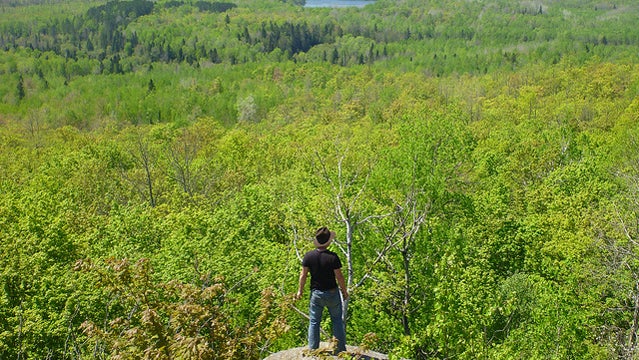Northern Wisconsin and the western portion of Michigan’s Upper Peninsula are rich in forests, rivers, and iron. In fact, iron mining is what gave birth to many towns in this region, before the industry fizzled out. It’s been decades since the area hosted a working iron mine, and now the regional economies mostly subsist (or, in some cases, barely subsist) on tourism and agriculture—and, in the case of the area’s Native American reservations, casinos.
���ϳԹ��� Ethics
Mary Catherine O’Connor and guest writers on environmental issues and the ethics of adventure.Metallic mining in Wisconsin, after all, is tightly regulated to protect water resources and avoid environmental damages that tend to last longer than mining profits.
Rather, it was tightly regulated, say opponents of Mining Bill SB 1, which Wisconsin Governor Scott Walker signed into law on Monday. The law, which was written with help from Gogebic Taconite, a mining company that is considering a large open pit iron mine in Northern Wisconsin, is designed to make the process of attaining permits to mine iron in the state more expedient. In the process, opponents say the law also reverses many of the state’s efforts to prevent environmental damages from iron mining.
The Gogebic Taconite mine would be located in the Penokee Hills, along a ridgeline roughly 50 miles south of Bayfield, a major destination for “silent sports” like sailing, paddling, fishing, hiking, and biking (not to mention hunting, snowmobiling, and various other sports). The hills (former mountains, geologically speaking) which have been referred to as the Alps of Wisconsin, contain stashes of singletrack on the Pines & Mines Trail, many hiking and cross-country ski trails, and trout streams.
The hills are a patchwork of public and private land, so if or when the mining operations begin, noise, dust, light, and visual pollution would very likely mar the experience of recreating in the area.
For Northern Wisconsin’s tourism industry, an iron mine in the Penokees would have a huge impact, says Meg Turville-Heitz, a Ph.D. candidate in the University of Wisconsin’s life science and communication program, who is writing her dissertation on the development and passage of the new mining law. Proponents of the Penokee mine say it would bring hundreds of jobs to the region and, when considering the demand for mining equipment, hundreds more manufacturing jobs. But at what costs to existing jobs?
“A lot of people are concerned,” says Turville-Heitz. “The amount of jobs that are being promised in connection to the proposed mine is around 2,000 statewide, but [the region] could lose more than it gains in the community of guides,” outfitters, campgrounds, and other services connected to tourism and recreation. The Penokees contain Class I, II, and III trout rivers and streams, which have natural brook, brown and rainbow trout.
Specific concerns around the impact a mine in the Penokees—which, if it happens, could become the largest taconite mine in the world—are based on water quality, the water table, and the dewatering, as well as the possibility that sulfides could be present in mine tailings and lead to acid mine drainage. Runoff from the mine site travels south but then flows around the ridge and drains north, through the Bad River Reservation and into the -rated wetlands of the Kakagon Slough, where the Bad River tribe maintains wild rice beds, and into Lake Superior.
“This is one of the biggest threats to public waters that we’ve seen in decades,” says Duke Welter, the Western Great Lakes conservation coordinator for Trout Unlimited, which opposes the legislation.
The new law changes the process and timeline by which companies seek iron mining permits from the state’s Department of Natural Resources, limiting the time the agency is given to decide an on application. The language of the law also states quite clearly that mining activity will result in environmental harm, and that is and is intended to deflect court challenges based on likely environmental impacts.
The law allows mining companies to fill waterways less than two miles long with debris. It says mining companies are required to mitigate impacts to waterways, but it does not require that those mitigations be done in the same watersheds that suffer harm. It also exempts the mining companies from paying the state a $7 fee per ton of waste rock—money that the state typically uses on recycling and other environmental initiatives.
LIKELY LEGAL CHALLENGES
The law’s allowances with respect to impacting waterways puts it in conflict with , which requires that the public be given access to any navigable waterways. Opposition groups therefore may file suit in order to fight, at the very least, that element of the law, says Turville-Heitz.
The site of the proposed mine also drains directly into the Bad River reservation of Lake Superior Chippewa, which might file suit based on its inability to ensure the quality of water entering the reservation should a mine dug into the Penokees sully the drainage. In fact, the Bad River tribe is already beginning to raise funds to mount a suit.
Pete Rasmussen, an opponent of the law and a resident of Ashland County, lives just outside the Penokees and says he often hears of available jobs in Ashland as well as neighboring Iron County (the Penokees straddle both counties, and Gogebic Taconite is based in Iron). The problem, he says, is that many locals lack the skills they need to fill these positions. If the state would spend money on job training programs in the area rather than on the infrastructure it would need to support massive iron mining operations, he says, the employment picture would improve much more quickly.
One especially promising local industry is agriculture, which has seen a boost since the local and organic food movements began taking root in the region. Rasmussen would like to see more government support for things like small-scale agriculture rather than large industrial projects such as iron mining.
“We have a legislature that said it would balance jobs and the environment and all it has done is push jobs at expense of the environment,” says Welter.


